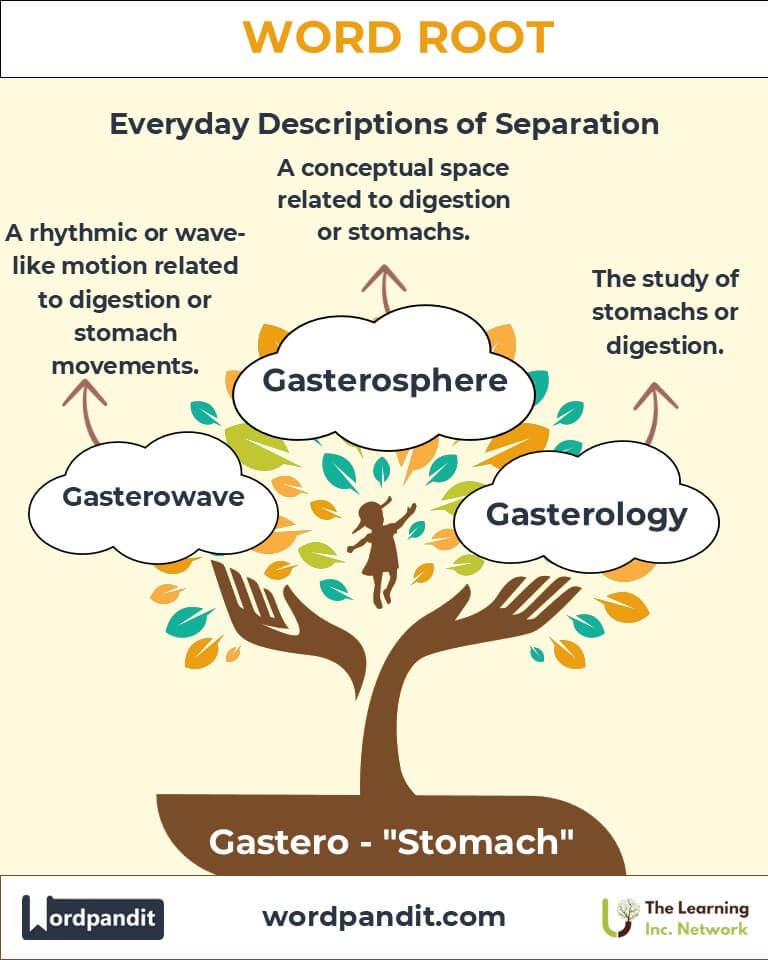Gastero: Exploring the Depths of the Stomach in Language and Science
Uncover the linguistic and scientific significance of "gastero," the root word meaning "stomach." From medical terms like "gastritis" to the fascinating creatures known as "gastropods," this root is a gateway to understanding our digestive system and beyond.

Table of Contents
- Introduction: The Essence of Gastero
- Etymology and Historical Journey
- Mnemonic: Unlocking the Power of Gastero
- Common Gastero-Related Terms
- Gastero Through Time
- Gastero in Specialized Fields
- Illustrative Story: Gastero in Action
- Cultural Significance of the Gastero Root
- The Gastero Family Tree
- FAQs about the Gastero Root
- Test Your Knowledge: Gastero Mastery Quiz
- Conclusion: The Living Legacy of Gastero
Introduction: The Essence of Gastero
Have you ever considered how your stomach, an essential organ for digestion, has shaped language and science? The word root "gastero," meaning "stomach," originates from Greek and is pronounced as "GAS-teh-roh." It forms the foundation of numerous terms in biology, medicine, and zoology. From describing inflammation in "gastritis" to classifying gastropods, this root reveals the interconnectedness of language and life.

Etymology and Historical Journey
The root "gastero" traces its origins to the Greek word gastēr, meaning "belly" or "stomach." It entered scientific discourse during the Renaissance when scholars adopted Greek and Latin terms to describe anatomical and zoological phenomena. Over time, "gastero" expanded to describe not just the human stomach but also the unique structures and adaptations in various organisms.
Mnemonic: Unlocking the Power of Gastero
Visualize a chef with a giant pot labeled "Gastero," stirring ingredients that represent health and knowledge. The "pot" symbolizes the stomach, a vessel for digestion and discovery.
Mnemonic Device: "Gastero—where knowledge and nourishment come together in life’s kitchen."
Common Gastero-Related Terms
- Gastritis (gas-TRY-tis):
- Definition: Inflammation of the stomach lining.
- Example: "Spicy foods can exacerbate gastritis symptoms in some people."
- Gastropod (GAS-tro-pod):
- Definition: A class of mollusks with a muscular foot and a stomach-like body.
- Example: "Snails and slugs are examples of gastropods."
- Gastroenterology (GAS-tro-en-ter-OL-oh-jee):
- Definition: The medical specialty focusing on the digestive system.
- Example: "A gastroenterologist diagnosed her with a stomach ulcer."
- Gastronomy (GAS-tron-oh-mee):
- Definition: The art and science of good eating.
- Example: "Paris is known as a global hub of gastronomy."
- Gastrovascular (GAS-tro-vas-cu-lar):
- Definition: Referring to a structure serving both digestive and circulatory functions, found in certain invertebrates.
- Example: "The gastrovascular cavity of jellyfish is crucial for nutrient distribution."
Gastero Through Time
- Ancient Medicine: The stomach was central to Hippocrates’ theories of humors and digestion. Early practitioners believed stomach health was critical to overall well-being.
- Modern Medicine: The rise of gastroenterology in the 20th century brought advancements in diagnosing and treating stomach-related illnesses, such as gastritis and ulcers.
- Biology and Zoology: The classification of gastropods emphasized the diversity of life forms with "stomach-footed" adaptations, such as snails.
Gastero in Specialized Fields
- Medicine:
- Gastroenteritis: Inflammation of the stomach and intestines caused by infection or irritation.
- Relevance: Critical for understanding global health concerns like foodborne illnesses.
- Zoology:
- Gastropoda: The largest class of mollusks, showcasing unique evolutionary adaptations.
- Example: "Shells of gastropods provide insights into marine biodiversity."
- Culinary Arts:
- Gastronomy: Celebrates cultural expressions of food and its preparation.
- Example: "Gastronomy explores the stomach's role as a cultural metaphor for pleasure."
Illustrative Story: Gastero in Action
Dr. Elena, a gastroenterologist, was puzzled by a patient’s persistent stomach pain. After conducting an endoscopy, she identified gastritis caused by an unusual bacterial strain. Simultaneously, her marine biologist friend, Leo, discovered a new species of gastropod while diving in coral reefs. Both professionals marveled at the wonders of the "gastero" root, linking human health to the mysteries of marine life.
Cultural Significance of the Gastero Root
The stomach’s cultural significance is profound. From ancient Roman feasts to modern culinary competitions, gastronomy reflects humanity’s celebration of food. Philosophically, the stomach is often metaphorically linked to appetite, desire, and satisfaction, echoing its central role in life and language.

The Gastero Family Tree
Here are related roots and terms that expand the "Gastero" lexicon:
- Entero- (Intestine):
- Example: Enteritis (inflammation of the intestines).
- Hepato- (Liver):
- Example: Hepatogastric (pertaining to the liver and stomach).
- Odonto- (Teeth):
- Example: Odontogastric (relating to teeth and stomach digestion).
FAQs About the "Gastero" Root
Q: What does "Gastero" mean?
A: "Gastero" is derived from the Greek word gastēr, meaning "stomach" or "belly." It is used in scientific and medical terminology to refer to anything related to the stomach or its functions. This root is integral in understanding digestive health, anatomy, and zoological classifications.
Q: What are gastropods?
A: Gastropods are a class of mollusks characterized by a "stomach-foot" body design. This unique structure allows them to move using a muscular foot located on the ventral side of their body. Examples include snails, slugs, and sea hares. Their name reflects the root "gastero" due to their anatomy's functional resemblance to a stomach.
Q: What is gastritis?
A: Gastritis refers to inflammation of the stomach lining. This condition can result from various causes, such as bacterial infections (e.g., Helicobacter pylori), prolonged use of NSAIDs, excessive alcohol consumption, or stress. Symptoms often include nausea, vomiting, stomach pain, and indigestion.
Q: How does "gastrovascular" differ from "gastrointestinal"?
A: "Gastrovascular" refers to a single cavity that functions both as a digestive and circulatory system, as seen in primitive animals like jellyfish and flatworms. In contrast, "gastrointestinal" refers to the complex digestive tract in humans and higher animals, including the stomach, intestines, and associated organs.
Q: What is gastronomy, and how is it more than just food?
A: Gastronomy is the art and science of good eating, encompassing the cultural, historical, and social dimensions of cuisine. It delves into the preparation, presentation, and appreciation of food, connecting dietary habits to human culture and innovation.
Q: What is a gastroenterologist, and what do they treat?
A: A gastroenterologist is a medical specialist focusing on diagnosing and treating disorders of the digestive system, which includes the stomach, intestines, liver, pancreas, and esophagus. Common conditions they address are ulcers, gastritis, acid reflux, irritable bowel syndrome (IBS), and colon cancer.
Test Your Knowledge: Gastero Mastery Quiz
1. What does the root "Gastero" mean?
2. Which term describes stomach inflammation?
3. What does a gastroenterologist study?
4. Which word refers to a mollusk with a stomach-foot structure?
5. What is the art and science of good eating called?
Conclusion: The Living Legacy of Gastero
The root "gastero" bridges the fields of medicine, zoology, and culture, symbolizing the stomach’s vital role in both survival and expression. Whether diagnosing ailments or marveling at gastropods, the influence of "gastero" is undeniable. Its legacy continues to expand, shaping our understanding of health, life, and the interconnected world around us.












